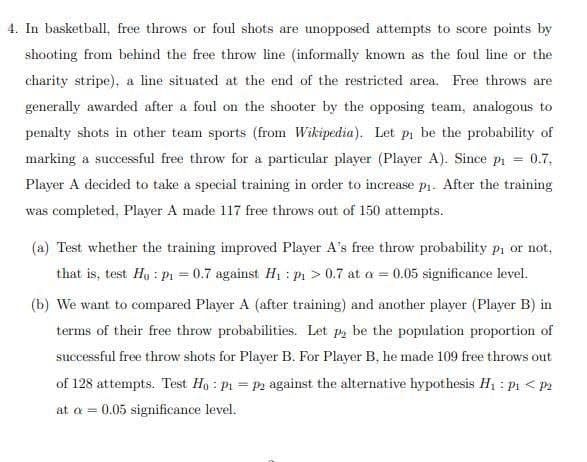4. In basketball, free throws or foul shots are unopposed attempts to score points by shooting from behind the free throw line (informally known as the foul line or the charity stripe), a line situated at the end of the restricted area. Free throws are generally awarded after a foul on the shooter by the opposing team, analogous to penalty shots in other team sports (from Wikipedia). Let pi be the probability of marking a successful free throw for a particular player (Player A). Since pi 0.7, Player A decided to take a special training in order to increase p1. After the training was completed, Player A made 117 free throws out of 150 attempts. (a) Test whether the training improved Player A's free throw probability p, or not, that is, test Hy: P = 0.7 against H : p > 0.7 at a 0.05 significance level. (b) We want to compared Player A (after training) and another player (Player B) in terms of their free throw probabilities. Let p, be the population proportion of successful free throw shots for Player B. For Player B, he made 109 free throws out of 128 attempts. Test Ho: pi = P2 against the alternative hypothesis H1 : p1 < P2 at a = 0.05 significance level.
4. In basketball, free throws or foul shots are unopposed attempts to score points by shooting from behind the free throw line (informally known as the foul line or the charity stripe), a line situated at the end of the restricted area. Free throws are generally awarded after a foul on the shooter by the opposing team, analogous to penalty shots in other team sports (from Wikipedia). Let pi be the probability of marking a successful free throw for a particular player (Player A). Since pi 0.7, Player A decided to take a special training in order to increase p1. After the training was completed, Player A made 117 free throws out of 150 attempts. (a) Test whether the training improved Player A's free throw probability p, or not, that is, test Hy: P = 0.7 against H : p > 0.7 at a 0.05 significance level. (b) We want to compared Player A (after training) and another player (Player B) in terms of their free throw probabilities. Let p, be the population proportion of successful free throw shots for Player B. For Player B, he made 109 free throws out of 128 attempts. Test Ho: pi = P2 against the alternative hypothesis H1 : p1 < P2 at a = 0.05 significance level.
Chapter8: Sequences, Series,and Probability
Section8.7: Probability
Problem 4ECP: Show that the probability of drawing a club at random from a standard deck of 52 playing cards is...
Related questions
Question

Transcribed Image Text:4. In basketball, free throws or foul shots are unopposed attempts to score points by
shooting from behind the free throw line (informally known as the foul line or the
charity stripe), a line situated at the end of the restricted area. Free throws are
generally awarded after a foul on the shooter by the opposing team, analogous to
penalty shots in other team sports (from Wikipedia). Let pi be the probability of
marking a successful free throw for a particular player (Player A). Since pi = 0.7,
Player A decided to take a special training in order to increase p1. After the training
was completed, Player A made 117 free throws out of 150 attempts.
(a) Test whether the training improved Player A's free throw probability Pi or not,
that is, test Hy : Pi = 0.7 against H1 : P > 0.7 at a = 0.05 significance level.
(b) We want to compared Player A (after training) and another player (Player B) in
terms of their free throw probabilities. Let p, be the population proportion of
successful free throw shots for Player B. For Player B, he made 109 free throws out
of 128 attempts. Test Ho : pr = P2 against the alternative hypothesis H1 : p1 < P2
at a = 0.05 significance level.
Expert Solution
This question has been solved!
Explore an expertly crafted, step-by-step solution for a thorough understanding of key concepts.
This is a popular solution!
Trending now
This is a popular solution!
Step by step
Solved in 4 steps with 3 images

Recommended textbooks for you

